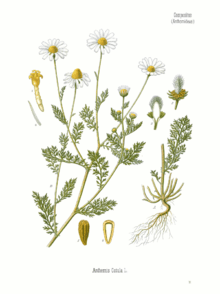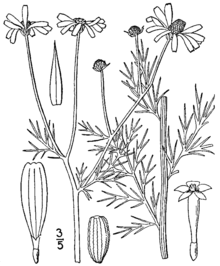Anthemis cotula
Anthemis cotula, also known as stinking chamomile,[6] is a flowering annual plant with a noticeable and strong odor. The odor is often considered unpleasant, and it is from this that it gains the common epithet "stinking". In pre-colonial times, its distribution was limited to the Old Continent and Africa; though it was established in most of Europe, it was not present in Finland, Ireland, or the northernmost reaches of Scotland, in spite of the fact that these countries feature climatic regions favorable to this plant and are in proximity to countries where the species is native, such as Russia, Estonia, Lithuania and England. It has successfully migrated to the New Europes[7] where it can be found growing in meadows, alongside roads, and in fields.[8]
| Anthemis cotula | |
|---|---|
 | |
| Stinking chamomile[1] | |
| Scientific classification | |
| Kingdom: | |
| (unranked): | |
| (unranked): | |
| (unranked): | |
| Order: | |
| Family: | |
| Tribe: | |
| Genus: | |
| Species: | A. cotula |
| Binomial name | |
| Anthemis cotula | |
| Synonyms[2][3][4][5] | |
| |
The name "cotula" is from a Greek word for "small cup", describing the shape of the flowers; it was assigned by Carl Linnaeus in his work Species Plantarum in 1753.[9]
Anthemis cotula is also known by a wide variety of other names, including mather, dog- or hog's-fennel, dog-finkle, dog-daisy, pig-sty-daisy, chigger-weed,[8] mayweed, Johnnyweed, maroute, Maruta cotula, Cotula Maruta foetida, Manzanilla loca, wild chamomile, Camomille puante. Foetid Chamomile, maithes, maithen, mathor[10] mayweed chamomile, camomille des chiens, camomille puante, stinkende Hundskamille, camomila-de-cachorro, macéla-fétida, and manzanilla hedionda.
Description
The "stinking chamomile" Anthemis cotula is so-named for its resemblance to the true chamomile plant, Anthemis nobilis; both have branching upright stems each topped by a single large flower head, although the "stinking chamomile" is distinguished by lacking the membraneous scales underneath the flowers of the true chamomile, as well as by its characteristic strong odor. The leaves of Anthemis cotula have a similar appearance to those of the fennel plant (Foeniculum vulgare), from which the name "Dog's Fennel" is derived.[11]
Anthemis cotula is an annual glandular plant with a harsh taste and an acrid smell. Its height varies from 12 inches (28 centimeters) to 24 inches (56 centimeters).[8]
- Leaves
- The leaves of the plant sometimes have very fine and soft hairs on the upper surface, although the plant is mostly hairless. There is no leaf stalk; leaves grow immediately from the stems. The leaves are pinnate in shape, with many extremely thin lobes, and can be around 1 or 2 inches (2.5 or 5.1 centimetres) long.[8]
- Flowers
- Each stem is topped by a single flower head which is usually around 1 inch (2.5 cm) in diameter. The flower head is encompassed by between 10 and 18 white ray florets, each with a three-toothed shape; the florets tend to curve downwards around the edges and may occasionally have pistils, although these do not produce fruit. Beneath the flower proper, oval bracts of the plant form an involucre, with soft hairs on each; further bracts are bristled and sit at right angles to the flowers.[8]
- Fruits
- The fruits are achenes (with no pappus). They are wrinkled, ribbed with ten ridges, and have small glandular bumps across the surface.
Toxicity
Anthemis cotula is potentially toxic to dogs, cats, horses, and guinea pigs. Clinical signs include contact dermatitis, vomiting, diarrhea, anorexia, allergic reactions. Long term use can lead to bleeding tendencies.[12] The foliage may also cause skin irritation.[13]
Distribution
- Native[7]
- Pale-arctic
- Macaronesia: Azores, Canary Islands, Madeira
- Southern Africa: Algeria, Egypt, Libya, Morocco, Tunisia
- Eurasia: Armenia, Azerbaijan, Kurdistan, Russia, Georgia, India, North Caucasus, Dagestan, Cyprus, Iran, Iraq, Palestine, Lebanon, Syria, Turkey
- Eastern Europe: Belarus, Estonia, Latvia, Lithuania, Crimea, Russia, Ukraine, Bulgaria
- Northern Europe: Denmark, Norway, Sweden, England, Scotland, Finland
- Central Europe: Austria, Czech Republic, Germany, Hungary, Poland, Switzerland
- Southern Europe: Albania, Bosnia and Herzegovina, Croatia, Greece, Crete, Italy, North Macedonia, Montenegro, Romania, Serbia, Sicily, Slovenia, Sardinia, Corsica, Portugal, Spain, Balearic Islands
- Western Europe: Belgium, Netherlands, France, Ireland, United Kingdom
- Introduced[14][15][16][17][18]
Naturalized in Americas, Southern Africa, and Oceania
Spread to United States
Johnny Appleseed planted stinking chamomile, here called dog-fennel, during his travels in the early 19th century, believing it to be an antimalarial. Dog-fennel already had a reputation for being an aggressive invasive, however, so Appleseed's practice invited controversy.[19] Harper's New Monthly Magazine in 1871 gave Appleseed credit for the overabundance of dogfennel:
The consequence was that successive, flourishing crops of the weed spread over the whole country and caused almost as much trouble as the disease it was intended to ward off; and to this day the dog-fennel, introduced by Johnny Appleseed, is one of the worst grievances of the Ohio farmers.[20]
References
- illustration from Köhler's Medizinal-Pflanzen in naturgetreuen Abbildungen mit kurz erläuterndem Texte : Atlas zur Pharmacopoea germanica. Author: Franz Eugen Köhler. 1883-1914
- The Plant List, Anthemis cotula L
- "Anthemis cotula". International Plant Names Index (IPNI). Royal Botanic Gardens, Kew. Retrieved 2008-06-17.
- Botanic Garden and Botanical Museum Berlin-Dahlem. "Details for: Anthemis cotula". Euro+Med PlantBase. Freie Universität Berlin. Retrieved 2008-06-17.
- UniProt. "Anthemis cotula". Retrieved 2008-06-17.
- Britten, James; Robert Holland (1886). "Page 84". A Dictionary of English Plant-names. For the English Dialect Society, Trübner & Ludgate Hill. p. 618 pages. Retrieved 2008-06-17.
- "Anthemis cotula". Germplasm Resources Information Network (GRIN). Agricultural Research Service (ARS), United States Department of Agriculture (USDA). Retrieved 2008-06-17.
- Britton, Nathaniel Lord; Addison Brown (1913). "BORAGE FAMILY". An Illustrated Flora of the Northern United States, Canada and the British Possessions From Newfoundland to the Parallel of the Southern Boundary of Virginia, and from the Atlantic Ocean Westward to the 102d Meridian. Volume III Gentianaceae to Compositae – Gentian to Thistle (Second Edition – Revised and Enlarged ed.). New York: Charles Scribner's Sons. Retrieved 2008-06-17.
- Dunglison, Robley; Richard James Dunglison (1876). "Section 22 Costohyoideus thru Cough". A Dictionary of Medical Science; Containing a Concise Explanation of the Various Subjects and Terms of Anatomy, Physiology, Pathology, Hygiene, Therapeutics, Medical Chemistry, Pharmacology, Pharmacy, Surgery, Obstetrics, Medical Jurisprudence, and Dentistry; Notices of Climate, and of Mineral Waters; Formulae for Officinal, Empirical, and Dietetic Preparations; with the Accentuation and Etymology of the Terms, and the French and Other Synonyms. Churchill. p. 1131 pages. Retrieved 2008-06-17.
- M. Grieve (1931). "Mayweed". A Modern Herbal. © Copyright Protected 1995-2008 Botanical.com. Archived from the original on 12 May 2008. Retrieved 2008-06-17.
- M. Grieve (1931). "Chamomile Stinking". A Modern Herbal. © Copyright Protected 1995-2008 Botanical.com. Archived from the original on 7 July 2008. Retrieved 2008-06-17.
- ASPCA - Pet Care - Mayweed
- Niering, William A.; Olmstead, Nancy C. (1985) [1979]. The Audubon Society Field Guide to North American Wildflowers, Eastern Region. Knopf. p. 358. ISBN 0-394-50432-1.
- Flora of North America
- Flora of China
- Biota of North America Program 2014 county distribution map
- Atlas of Living Australia
- Cabrera, A. L. 1978. Compositae. 10: 1–726. In A. L. Cabrera (ed.) Flora de la provincia de Jujuy. Instituto Nacional de Tecnología Agropecuaria, Buenos Aires
- Haley, William D’Arcy (November 1871). "Johnny Appleseed. A pioneer hero". Harper's Magazine. ISSN 0017-789X. Retrieved 2019-11-09.
- Haley, W. D. (1955). Johnny Appleseed : a pioneer hero. Allen County Public Library Genealogy Center. [Fort Wayne, Ind.] : Public Library of Fort Wayne and Allen County.
External links
![]()
![]()
- "Anthemis cotula L." Integrated Taxonomic Information System. Retrieved 17 June 2008.
- "Anthemis cotula". Natural Resources Conservation Service PLANTS Database. USDA. Retrieved 2008-06-17.
- Blanchan, Neltje (1917): Wild Flowers Worth Knowing. HTML or TXT fulltext at Project Gutenberg
- Phillpotts, Eden (1900). "ANTHEMIS COTULA". Sons of the Morning. Putnam. pp. 61–71 of 492 pages. Retrieved 2008-06-17.
